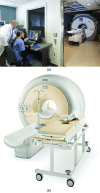MR-guided focused ultrasound surgery, present and future
- PMID: 23927296
- PMCID: PMC3724793
- DOI: 10.1118/1.4811136
MR-guided focused ultrasound surgery, present and future
Abstract
MR-guided focused ultrasound surgery (MRgFUS) is a quickly developing technology with potential applications across a spectrum of indications traditionally within the domain of radiation oncology. Especially for applications where focal treatment is the preferred technique (for example, radiosurgery), MRgFUS has the potential to be a disruptive technology that could shift traditional patterns of care. While currently cleared in the United States for the noninvasive treatment of uterine fibroids and bone metastases, a wide range of clinical trials are currently underway, and the number of publications describing advances in MRgFUS is increasing. However, for MRgFUS to make the transition from a research curiosity to a clinical standard of care, a variety of challenges, technical, financial, clinical, and practical, must be overcome. This installment of the Vision 20∕20 series examines the current status of MRgFUS, focusing on the hurdles the technology faces before it can cross over from a research technique to a standard fixture in the clinic. It then reviews current and near-term technical developments which may overcome these hurdles and allow MRgFUS to break through into clinical practice.
Figures








References
Publication types
MeSH terms
Grants and funding
LinkOut - more resources
Full Text Sources
Other Literature Sources
Medical

